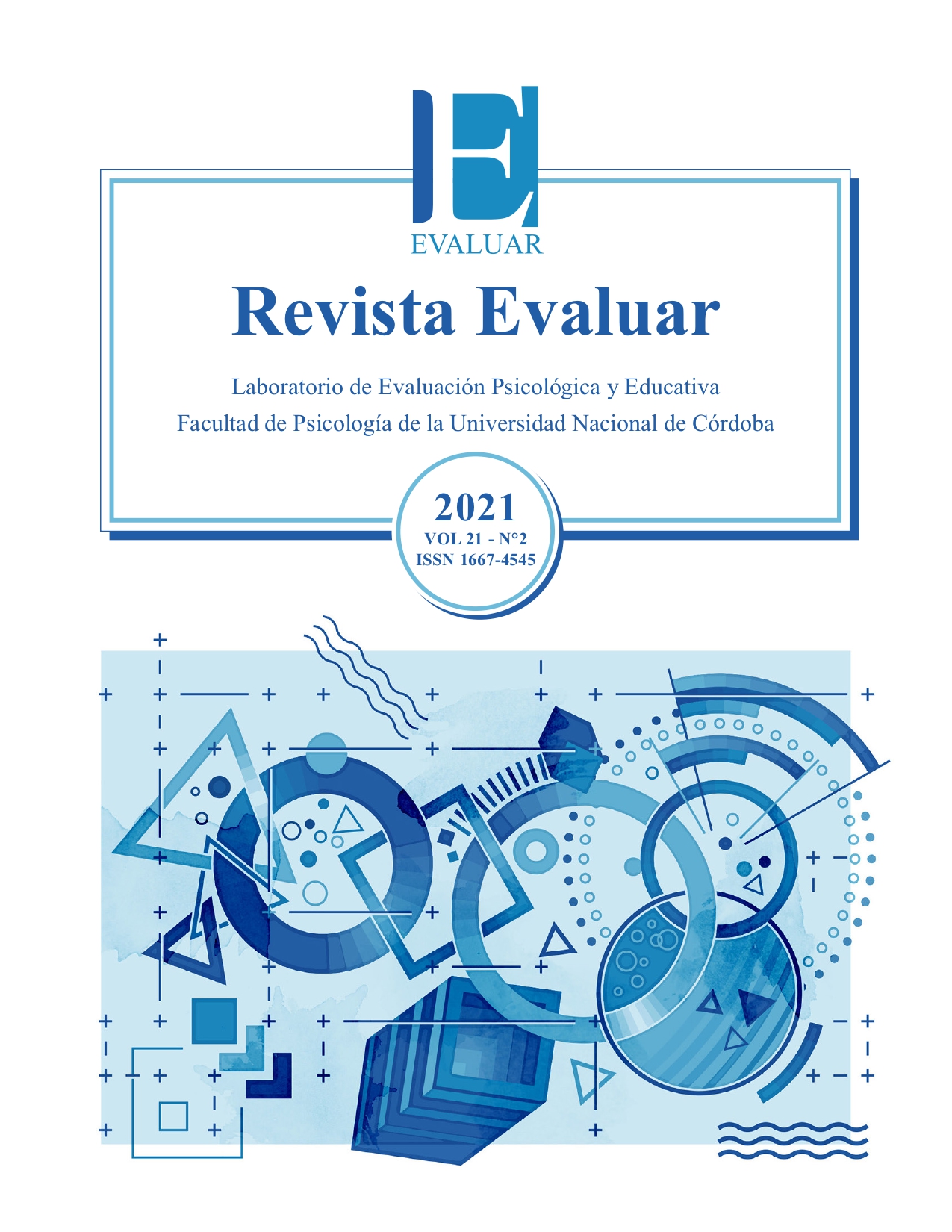Psychometric Properties of the Hopkins Symptom Checklist (HSCL-11) in Argentina: An instrument for monitoring and feedback in Psychotherapy
DOI:
https://doi.org/10.35670/1667-4545.v21.n2.34393Keywords:
Hopkins Symptom Check-Lists Argentine version, psychometric properties, validity, reliability, psychiatric symptomatology, anxiety, depression, psychotherapy monitoringAbstract
We failed to find brief instruments validated in Argentina to explore and monitor psychological symptoms from psychotherapy patients. This paper presents the Argentinian adaptation of the Hopkins Symptoms Checklist (HSCL-11) and analyzes its psychometric properties. A sample of 356 participants completed the HSCL-11 adaptation, along with other measures of depression, anxiety, and well-being. We analyzed Cronbach’s alpha and item-total correlations adjusted. We ran confirmatory factor analysis, correlations among the measures, and examined differences in HSCL-11 between subjects who were psychotherapy patients and those who were not. We found evidence of adequate internal consistency and item homogeneity, as well as construct validity, concurrent validity, and criterion validity. Results showed evidence of reliability and validity for the HSCL-11 Argentinian adaptation, suggesting that it might represent a meaningful resource for the evaluation and treatment of mental disorders in Argentina.
Downloads
References
Abuín, M. R., & de Rivera, L. (2014). La medición de síntomas psicológicos y psicosomáticos: El Listado de Síntomas Breve (LSB-50). Clínica y Salud, 25(2), 131-141. doi: 10.1016/j.clysa.2014.06.001
Allaire, J. J., Xie, Y., McPherson, J., Luraschi, J., Ushey, K., Atkins, A., ... & Iannone, R. (2020). Rmarkdown: Dynamic Documents for R (2.6). [Software de cómputo]. Recuperado de https://rmarkdown.rstudio.com
Areas, M., Roussos, A., Hirsch, H., Hirsch, P., Becerra, P., & Gómez-Penedo, J. M. (2018). Evaluación de un dispositivo de investigación orientada por la práctica para el desarrollo de un sistema de feedback en psicoterapia. Revista Argentina de Clínica Psicológica, 27(2), 229-249. doi: 10.24205/03276716.2018.1064
Barros, J., Morales, S., García, A., Echávarri, O., Fischman, R., Szmulewicz, M., … & Tomicic, A. (2020). Recognizing states of psychological vulnerability to suicidal behavior: A Bayesian network of artificial intelligence applied to a clinical sample. BMC Psychiatry, 20, 138. doi: 10.1186/s12888-020-02535-x
Boswell, J. F., Constantino, M. J., Kraus, D. R., Bugatti, M., & Oswald, J. M. (2015). The expanding relevance of routinely collected outcome data for mental health care decision making. Administration and Policy in Mental Health and Mental Health Services Research, 43, 482-491. doi: 10.1007/s10488-015-0649-6
Botella i García del Cid, L. (2008). Resultado y proceso en Psicoterapia Cognitivo-Constructivista Integradora. Apuntes de Psicología, 26(2), 229-241. Recuperado de http://www.apuntesdepsicologia.es/index.php/revista/index
Casullo, M. (1999/2008). El inventario de síntomas SCL-90-R de L. Derogatis. Documento de Trabajo. Facultad de Psicología, UBA. Recuperado de http://www.fundacionforo.com/pdfs/inventariodesintomas.pdf
Chisholm, D., Sweeny, K., Sheehan, P., Rasmussen, B., Smit, F., Cuijpers, P., & Saxena, S. (2016). Scaling-up treatment of depression and anxiety: A global return on investment analysis. The Lancet Psychiatry, 3(5), 415-424. doi: 10.1016/S2215-0366(16)30024-4
Constantino, M. J., Coyne, A. E., & Muir, H. J. (2020). Evidence-based therapist responsivity to disruptive clinical process. Cognitive and Behavioral Practice, 27(4), 405-416. doi: 10.1016/j.cbpra.2020.01.003
Cornelio, C., & Contreras, A. (2020). WHO-5 Index: Validez, confiabilidad y aplicaciones de una escala para evaluar el bienestar subjetivo en salud laboral. Documento técnico. Ministerio de Trabajo, Empleo y Seguridad Social. Recuperado de https://www.argentina.gob.ar/srt/observatorio-srt
De la Iglesia, G., Stover, J. B., Castro-Solano, A., & Fernández-Liporace, M. (2015). Validez de constructo del LSB-50 en adultos argentinos: Validación cruzada e invarianza factorial. Acción Psicológica, 12(2), 43-58. doi: 10.5944/ap.12.2.15327
Delgadillo, J., & Lutz, W. (2020). A development pathway towards precision mental health care. JAMA Psychiatry, 77(9), 889-890. doi: 10.1001/jamapsychiatry.2020.1048
Derogatis, L. R. (1983). SCL-90-R: Administration, Scoring and Procedures Manual II for the R (evised) Version of the SCL-90. Baltimore, MD: John Hopkins University School of Medicine, Clinical Psychometric Research.
Elosua-Oliden, P., & Zumbo, B. D. (2008). Coeficientes de fiabilidad para escalas de respuesta categórica ordenada. Psicothema, 20(4), 896-901. Recuperado de http://www.psicothema.com
Emmelkamp, P. M. G., David, D., Beckers, T., Muris, P., Cuijpers, P., Lutz, W., ... & Vervliet, B. (2014). Advancing psychotherapy and evidence-based psychological interventions. International Journal of Methods in Psychiatric Research, 23(S1), 58-91. doi: 10.1002/mpr.1411
Feixas, G., Evans, C., Trujillo, A., Saúl, L. A., Botella, L., Corbella, S., ... & López-González, M. A. (2012). La versión española del CORE-OM: Clinical Outcomes in Routine Evaluation - Outcome Measure. Revista de Psicoterapia, 23(89), 109-135. Recuperado de https://ojs.revistadepsicoterapia.com/index.php
Fernández-Álvarez, J., Fernández-Álvarez, H., & Castonguay, L. G. (2018). Resumiendo los nuevos esfuerzos para integrar la práctica y la investigación desde la perspectiva de la investigación orientada por la práctica. Revista Argentina de Clínica Psicológica, 27(2), 353-372. doi: 10.24205/03276716.2018.1070
Fernández-Álvarez, H., Hirsch, H., Maristany, M., & Torrente, F. (2005). Propiedades psicométricas del OQ-45.2 en la Argentina: Un estudio piloto. Poster presentado en el 4° Congreso Mundial de Psicoterapia, Buenos Aires.
Freiberg-Hoffmann, A., Stover, J. B., de la Iglesia, G., & Fernández-Liporace, M. (2013). Correlaciones policóricas y tetracóricas en estudios factoriales exploratorios y confirmatorios. Ciencias Psicológicas, 7(2), 151-164. Recuperado de https://revistas.ucu.edu.uy/index.php/cienciaspsicologicas
Gadermann, A. M., Guhn, M., & Zumbo, B. D. (2012). Estimating ordinal reliability for likert-type and ordinal item response data: A conceptual, empirical, and practical guide. Practical Assessment, Research and Evaluation, 17, Art. 3. Recuperado de https://scholarworks.
umass.edu/pare
García-Campayo, J., Zamorano, E., Ruiz, M. A., Pardo, A., Pérez-Páramo, M., López-Gómez, V., ... & Rejas, J. (2010). Cultural adaptation into Spanish of the generalized anxiety disorder-7 (GAD-7) scale as a screening tool. Health and Quality of Life Outcomes, 8, Art. 8. doi: 10.1186/1477-7525-8-8
Gómez-Penedo, J. M., Zilcha-Mano, S., & Roussos, A. (2019). Interpersonal profiles in emotional disorders predict the importance of alliance negotiation for early treatment outcome. Journal of Consulting and Clinical Psychology, 87(7), 617-628. doi: 10.1037/ccp0000417
Goodwin, L. D., & Leech, N. L. (2006). Understanding correlation: Factors that affect the size of r. Journal of Experimental Education, 74(3), 249-266. doi: 10.3200/JEXE.74.3.249-266
Harrell, F. E. Jr. (2020). Hmisc: Harrell Miscellaneous. R package version 4.4-0. [Rstudio]. Recuperado de https://CRAN.R-project.org/package=Hmisc
Jacobson, N. S., & Truax, P. (1991). Clinical significance: A statistical approach to defining meaningful change in psychotherapy research. Journal of Consulting and Clinical Psychology, 59(1), 12-19. doi: 10.1037/0022-006X.59.1.12
Kroenke, K., Spitzer, R. L., & Williams, J. B. (2001). The PHQ-9: Validity of a brief depression severity measure. Journal of General Internal Medicine, 16(9), 606-613. doi: 10.1046/j.1525-1497.2001.016009606.x
Lambert, M. J. (2013). Outcome in psychotherapy: The past and important advances. Psychotherapy, 50(1), 42-51. doi: 10.1037/a0030682
Lambert, M., Hansen, N., Umpress, V., Lunnen, K., Okiiski, J., Burlingame, G., & Reisinger, C. W. (1996). Administration and Scoring Manual for the Outcome Questionnarie (OQ45-2). Wilmington, DE: American Professional Credentialing.
Lara, C., Cruz, C., Vacarezza, A., Florenzano, R., & Trapp, A. (2008). Análisis comparativo de dos instrumentos de evaluación clínica: OQ-45 e interRAI- Salud Mental. Revista Chilena de Neuro-psiquiatría, 46(3), 192-198. doi: 10.4067/S0717-92272008000300004
Li, C. -H. (2016). The performance of ML, DWLS, and ULS estimation with robust corrections in structural equation models with ordinal variables. Psychological Methods, 21(3), 369-387. doi: 10.1037/met0000093
Lucas-Carrasco, R. (2012). The WHO Quality Of Life (WHOQOL) Questionnaire: Spanish development and validation studies. Quality of Life Research, 21(1), 161-165. doi: 10.1007/s11136-011-9926-3
Lutz, W., Tholen, S., Schürch, E., & Berking, M. (2006). Die Entwicklung, Validierung und Reliabilität von Kurzformen gängiger psychometrischer Instrumente zur Evaluation destherapeutischen Fortschritts in Psychotherapie und Psychiatrie. Diagnostica, 52(1), 11-25. doi: 10.1026/0012-1924.52.1.11
Lutz, W., de Jong, K., & Rubel, J. (2015). Patient-focused and feedback research in psychotherapy: Where are we and where do we want to go? Psychotherapy Research, 25(6), 625-632. doi: 10.1080/10503307.2015.1079661
Lutz, W., Rubel, J. A., Schwartz, B., Schilling, V., & Deisenhofer, A. (2019). Towards integrating personalized feedback research into clinical practice: Development of the Trier Treatment Navigator (TTN). Behaviour Research and Therapy, 120, 103438. doi: 10.1016/j.brat.2019.103438
Mîndrilă, D. (2010). Maximum Likelihood (ML) and Diagonally Weighted Least Squares (DWLS) estimation procedures: A comparison of estimation bias with ordinal and multivariate non-normal data. International Journal of Digital Society, 1(1), 60-66. doi: 10.20533/ijds.2040.2570.2010.0010
Organización Mundial de la Salud. (1998). Wellbeing measure in primary health care/The Depcare Project. Copenhagen, Denmark: WHO Regional Office for Europe.
Paz, C., Mascialino, G., & Evans, C. (2020). Exploration of the psychometric properties of the Clinical Outcomes in Routine Evaluation-Outcome Measure in Ecuador. BMC Psychology, 8(1), Art. 94. doi: 10.1186/s40359-020-00443-z
R Core Team. (2020). R: A language and environment for statistical computing. [Software de cómputo]. R Foundation for Statistical Computing, Vienna, Austria. Recuperado de https://www.R-project.org
Rattray, J., & Jones, M. C. (2007). Essential elements of questionnaire design and development. Journal of Clinical Nursing, 16(2), 234-243. doi: 10.1111/j.1365-2702.2006.01573.x
Revelle, W. (2019). psych: Procedures for personality and psychological research (1.9.12). [Software de cómputo]. Recuperado de https://CRAN.R-project.org
Rial-Boubeta, A., Varela-Mallou, J., Abalo-Piñeiro, J., & Lévy-Mangin, J. P. (2006). El análisis factorial confirmatorio. En J. P. Lévy-Mangin & J. Varela-Mallou (Eds.), Modelización con estructuras de covarianzas en ciencias sociales (pp. 119-154). Coruña, España: Netbiblo.
Rosseel, Y. (2012). lavaan: An R package for structural equation modeling. Journal of Statistical Software, 48(2), 1-36. doi: 10.18637/jss.v048.i02
Roussos, A. J., Gómez-Penedo, J. M., & Muiños, R. (2018). A time-series analysis of therapeutic alliance, interventions, and client’s clinical status in an evidence-based single-case study: Evidence for establishing change mechanisms in psychotherapy. Psychotherapy Research, 28(1), 137-149. doi: 10.1080/10503307.2016.1174346
Schumacker, R. E., & Lomax, R. G. (2004). A beginner’s guide to structural equation modeling (4a ed.). New York, NY:. Psychology Press. doi: 10.4324/9781410610904
Sosa-Torralba, J. E., Romero-Mendoza, M. P., Medina-Mora-Icaza, M. E., Méndez-Ríos, E., & Blum-Grynberg, B. (2020). Estructura dimensional de la Escala Clinical Outcomes in Routine Evaluation-Outcome Measure (CORE-OM) en universitarios mexicanos. Revista Evaluar, 20(1), 49-66. Recuperado de https://revistas.unc.edu.ar/index.php/revaluar
Spitzer, R. L., Kroenke, K., Williams, J. B., & Löwe, B. (2006). A brief measure for assessing generalized anxiety disorder: the GAD-7. Archives of Internal Medicine, 166(10), 1092-1097. doi: 10.1001/archinte.166.10.1092
Stover, J. B., Uriel, F., & Fernández-Liporace, M. (2012). Inventario de estrategias de aprendizaje y estudio: Análisis psicométricos de una versión abreviada. Revista Argentina de Ciencias Del Comportamiento, 4(3), 4-12. Recuperado de https://revistas.unc.edu.ar/index.php/racc
Tavakol, M., & Dennick, R. (2011). Making sense of Cronbach’s alpha. International Journal of Medical Education, 2, 53-55. doi: 10.5116/ijme.4dfb.8dfd
Urtasun, M., Daray, F. M., Teti., G. L., Coppolillo, F., Herlax, G., Saba, G., ... & Irazola, V. (2019). Validation and calibration of the Patient Health Questionnaire (PHQ-9) in Argentina. BMC Psychiatry, 19(1), Art. 291. doi: 10.1186/s12888-019-2262-9
Zilcha-Mano, S., & Errázuriz, P. (2015). One size does not fit all: Examining heterogeneity and identifying moderators of the alliance-outcome association. Journal of Counseling Psychology, 62(4), 579-591. doi: 10.1037/cou0000103
Zumbo, B. D., Gadermann, A. M., & Zeisser, C. (2007). Ordinal versions of coefficients alpha and theta for Likert rating scales. Journal of Modern Applied Statistical Methods, 6(1), 21-29. doi: 10.22237/jmasm/1177992180
Downloads
Published
How to Cite
Issue
Section
License
Copyright (c) 2021 Juan Martín Gómez-Penedo, Malenka Alejandra Areas, Rocío Manubens, Anna Margarete Babl, Laura Challú, Santiago Juan, Roberto Muiños, Javier Fernández-Álvarez, Nicolás Alalú, Andrés Roussos, Wolfgang Lutz, Martin grosse-Holtforth Martin grosse-Holtforth

This work is licensed under a Creative Commons Attribution 4.0 International License.
Revista Evaluar aplica la Licencia Internacional de Atribuciones Comunes Creativas (Creative Commons Attribution License, CCAL). Bajo esta licencia, los autores retienen la propiedad de copyright de los artículos pero permiten que, sin que medie permiso de autor o editor, cualquier persona descargue y distribuya los artículos publicados en Evaluar. La única condición es que siempre y en todos los casos se cite a los autores y a la fuente original de publicación (i.e. Evaluar). El envío de artículos a Evaluar y la lectura de los mismos es totalmente gratuito.




_(3).jpg)



.jpg)



